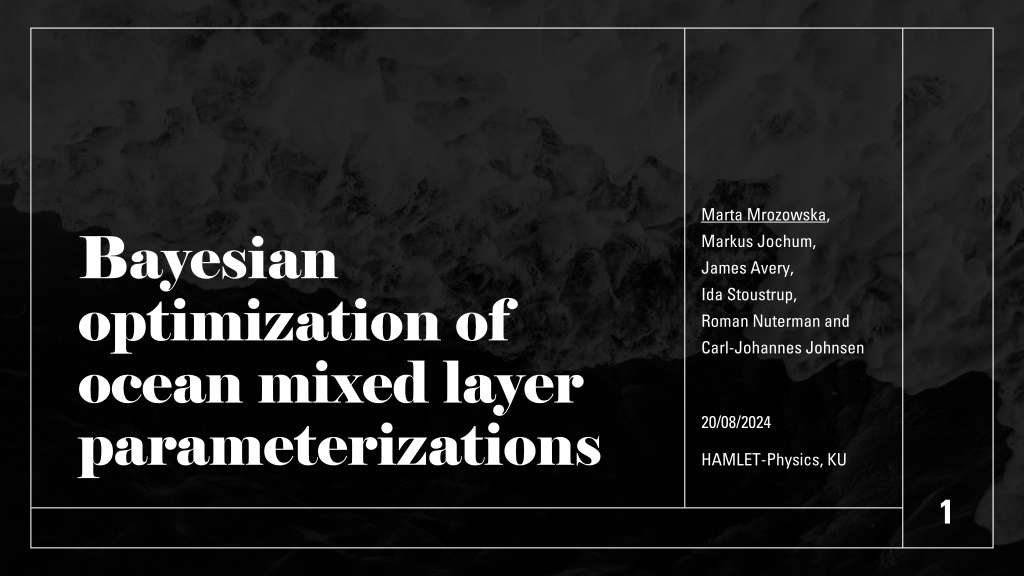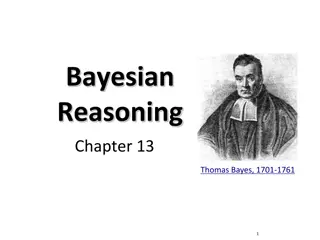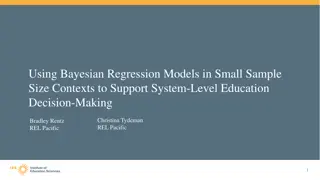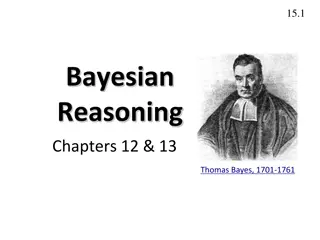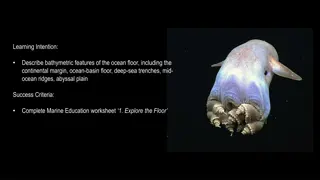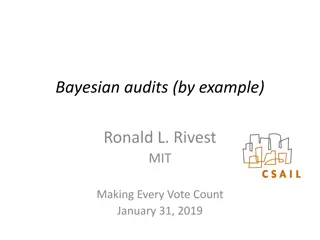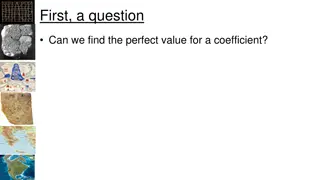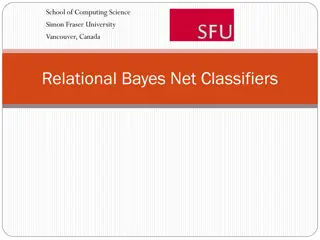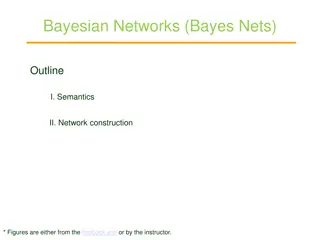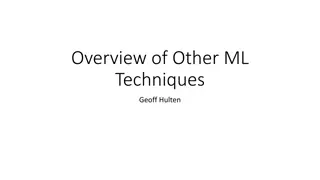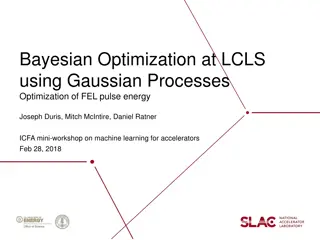Bayesian Optimization in Ocean Modeling
Utilizing Bayesian optimization in ocean modeling, this research explores optimizing mixed layer parameterizations and turbulent kinetic energy closure schemes. It addresses challenges like expensive evaluations of objective functions and the uncertainty of vertical mixing, presenting a solution through surrogate modeling and optimal parameter selection. The agenda covers Gaussian process regression models, VerOpt for Bayesian optimization, and optimizing closure schemes in Veros. Rare events like yacht sinking due to water spouts and tropical SST anomalies restructuring the global atmosphere are also discussed.
Download Presentation

Please find below an Image/Link to download the presentation.
The content on the website is provided AS IS for your information and personal use only. It may not be sold, licensed, or shared on other websites without obtaining consent from the author.If you encounter any issues during the download, it is possible that the publisher has removed the file from their server.
You are allowed to download the files provided on this website for personal or commercial use, subject to the condition that they are used lawfully. All files are the property of their respective owners.
The content on the website is provided AS IS for your information and personal use only. It may not be sold, licensed, or shared on other websites without obtaining consent from the author.
E N D
Presentation Transcript
Marta Mrozowska, Markus Jochum, James Avery, Ida Stoustrup, Roman Nuterman and Carl-Johannes Johnsen Bayesian optimization of ocean mixed layer parameterizations 20/08/2024 HAMLET-Physics, KU 1
Super yacht Bayesian sinks after encounter with extremely rare water spout (20/8/24, FT) 2
Tropical SST anomalies can lead to restructuring of the global atmosphere 3 Jochum et al. (2013)
One of the largest sources of uncertainty is vertical mixing Vertical turbulent mixing creates a homogeneous surface layer that, like a skin, exchanges heat and momentum with the atmosphere Mixing is difficult to observe, but the mixed layer depth (MLD) is well observed and a key metric for model performance A rare direct observation of a strong mixing event (Hummels et al. 2020). The turbulent diffusivity (3 orders larger than molecular) is shown in panel c. 4 Foltz et al. (2003)
Veros: Versatile Ocean Simulator Python/JAX MPI for GPUs Fortran on 2000 CPUs or Python/JAX on 16 A100 GPUs at a fifth of the energy! 5 H fner et al. (2021) Fortran: the Diesel of climate models!
The Problem We want to optimize the objective function ?: ? We don t know anything about the function shape (so-called black box objective function) The objective function is expensive to evaluate 6
The Solution: Bayesian Optimization Based on a few objective function evaluations, construct a surrogate model of the objective function over the full parameter space Using the model of the objective function, decide the next optimal parameter set to evaluate 7
Agenda 1. Gaussian process regression models 2. Bayesian optimization with VerOpt 3. Optimizing the turbulent kinetic energy closure scheme in Veros 8
Gaussian process (GP) regression models 9
?12= ?21= 0.9 ?1 ?2, ?11 ?21 ?12 ?22 ?1 ?2 ? 10
?12= ?21= 0.3 ?1 ?2, ?11 ?21 ?12 ?22 ?1 ?2 ? 11
? ?(?,?) ? = ?2 ?3, ?22 ?32 ?23 ?33 ?2 ?3 ? ?23= ?32 0.95 12
? ?(?,?) ? = ?2 ?9, ?22 ?92 ?29 ?99 ?2 ?9 ? ?23= ?32 0.09 13
GP regression generalized ? X: a set of input points X*: a set of test points Joint distribution: ? ? ? ? ~? ?(?) ?(? ), ? ? ? 14
GP regression generalized ? X: a set of input points X*: a set of test points Conditional distribution: ? |?,?,? ~?(? ?? 1?,? ? ?? 1?) ? 15
The kernel ?(?1,?1) ?(??,?1) ?(?1,??) ?(??,??) 1 ? = 2?2? ? 2 ? ?,? = exp 16
Bayesian Optimization with VerOpt 17
Step 2: Construct an initial GP model by minimizing the log marginal likelihood with respect to the kernel hyperparameters. 23
Interlude: Learning the GP model hyperparameter(s) log(MLL) = data fit + simplicity + normalization factor 24 Stoustrup (2021)
Step 3: Suggest new points to evaluate by optimizing the UCB acquisition function 25
Step 4: Construct a GP model using the updated set of evaluated points 27
Optimizing the TKE closure scheme in Veros 29
Turbulent Kinetic Energy (TKE) ?? ?? ?? ?? Turbulent fluxes: ? = ?? ? ? = ? ? 3 2 2 ?? ??= ? ?? ?? ?? ? ? ?2? + ?? ?? ?? Prognostic TKE equation: ?? ?? TKE diffusion TKE dissipation Buoyancy flux Shear production Parameterization of eddy diffusivities: ? =?? ??= ?????? ? = ??? ? ?? Free parameters: Default values: ??= 0.1, ??= 0.7, ????= 30 ?? [0,1] ?? [0,1] ???? 30 Gaspar et al. (1990)
MLD optimization Model: 2 ?,? ??? ????,? ????,? ??? ????,? 1 Objective function: ??? ?? ?,?=0,0 Veros 1 x1 60 vertical layers 2.5m surface resolution Forced by ECMWF reanalysis winds (ie observations assimilated into numerical model Setup: Duration of simulation: 30 years Initial points: 10 Bayes points: 30 Evaluations per step: 2 31 ERA-Interim: Dee et al. (2011); Ifremer MLD: De Boyer Mont gutet al. (2022)
Optimization results The default TKE parameterization lays within the parameter space region where the MLD bias is minimized. 32
Optimization results The default TKE parameterization lays within the parameter space region where the MLD bias is minimized. (lab experiments suggest 0.05-0.2), Ie the amount of energy converted To potential energy and not heat) ?? ???= 1 ?? 33
Why use Bayesian optimization? The method is transparent (not a black box) Does not rely on gradients Relatively few objective function evaluations are needed Easy to build with Python packages such as PyTorch Has just last week been ported to LUMI to optimize a 9-d parameter space on 1000 GPUs! 34
Thank you for your attention! 35 Supported by E U project N extG E M S, the L U M I consortium and the D anish C enter of C lim ate C om puting at K U
